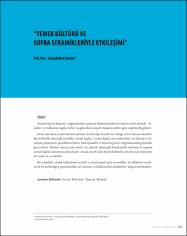| dc.date.accessioned | 2020-06-26T12:29:27Z | |
| dc.date.available | 2020-06-26T12:29:27Z | |
| dc.date.issued | 2017 | en_US |
| dc.identifier.citation | Sevim, C. (2017). Yemek kültürü ve sofra seramikleriyle etkileşimi. Sanat ve Tasarım Dergisi, 7 (2), 195-206. | en_US |
| dc.identifier.issn | 2146-7692 | |
| dc.identifier.uri | https://hdl.handle.net/11421/23517 | |
| dc.description.abstract | İnsanın hayatı boyunca vazgeçemediği yaşamsal ihtiyaçlarından bir tanesi yemek yemedir. Yemekler ve kullanılan kaplar kültür ve geleneklere dayalı olarak tercihlere göre değişkenlik gösterir.
İnsan, yemek ve yemek kabının ayrılmaz birlikteliği insanlık var olduğu sürece devam edecektir.
Bu birliktelik sürecinde yemekler, yemek kapları, yemek kaplarının malzemeleri ve biçimleri teknolojik gelişmelerin paralelinde kültür, fonksiyonellik ve kişisel beğeniler doğrultusunda gelişmeler
göstermiştir. Tarihsel süreçte cam, metal, taş, plastik, ahşap gibi birçok farklı malzeme ile yapılan
yemek kapları karşımıza çıkmaktadır. Ancak yemek kabı olarak kullanılan en eski malzemelerden
bir tanesi de seramiktir.
Bu makalede yemek kültürünün artistik ve fonksiyonel sofra seramikleri ile etkileşimi incelenerek bu birlikteliğin günümüzdeki son durumu ve kullanıcıların beklentileri değerlendirilecektir. | en_US |
| dc.description.abstract | One of the vital necessities that people can not give up throughout their lives is food. Meals and
table ware may vary from one person to anohter considering individual preferences, cultural and
traditional diferences.
Te inseperable association of human beings, food and table ware will continue to exist as long
as humanity exist. In the course of time, dishes, food containers, their shpaes and materials they
are made from have changed due to the advancements in technology, cultural diversity, diferent
traditions, personal preferences and functionality. In the history, there existed table ware made of
glass, metal, stone, plastic, wood and many other materials avalaible in the past. However, one of
the oldest materials used in making tableware is ceramics.
Tis article sheds light into the interaction between the artistic and functional tableware ceramics and the food culture; states the present situation of this association of human beings, food and
table ware; and finally evaluates the expectations of the users. | en_US |
| dc.language.iso | tur | en_US |
| dc.publisher | Anadolu Üniversitesi | en_US |
| dc.rights | info:eu-repo/semantics/openAccess | en_US |
| dc.subject | Lezzet | en_US |
| dc.subject | Beslenme | en_US |
| dc.subject | Tasarım | en_US |
| dc.subject | Seramik | en_US |
| dc.subject | Taste | en_US |
| dc.subject | Nutrition | en_US |
| dc.subject | Design | en_US |
| dc.subject | Ceramic | en_US |
| dc.title | Yemek kültürü ve sofra seramikleriyle etkileşimi | en_US |
| dc.title.alternative | Interaction of ceramic tableware with food culture | en_US |
| dc.type | article | en_US |
| dc.relation.journal | Sanat ve Tasarım Dergisi | en_US |
| dc.contributor.department | Anadolu Üniversitesi, Güzel Sanatlar Fakültesi, Seramik Bölümü | en_US |
| dc.identifier.volume | 7 | en_US |
| dc.identifier.issue | 2 | en_US |
| dc.identifier.startpage | 195 | en_US |
| dc.identifier.endpage | 206 | en_US |
| dc.relation.publicationcategory | Makale - Ulusal Hakemli Dergi - Kurum Öğretim Elemanı | en_US |
| dc.contributor.institutionauthor | Sevim, Cemalettin | |


















